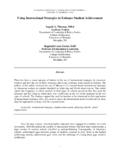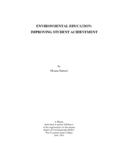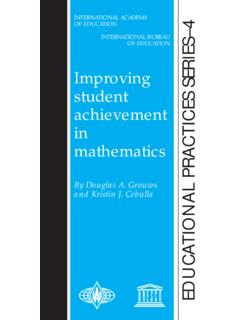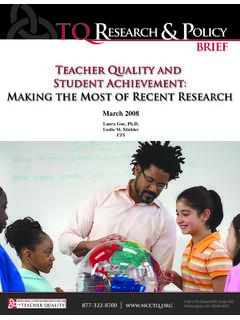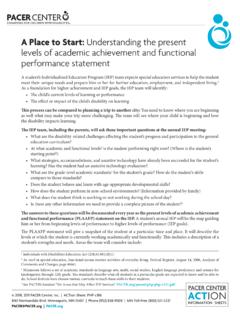Transcription of A Case Study of the “Pygmalion Effect”: Teacher ...
1 International Education Studies Vol. 4, No. 1; February 2011 ISSN 1913-9020 E-ISSN 1913-9039 198A Case Study of the Pygmalion Effect : Teacher Expectations and Student achievement Jie Chang English Department, Beijing Institute of Petrochemical Technology Qingyuan North Road, Beijing 106217, China E-mail: Abstract The Pygmalion effect usually refers to the fact that people, often children , students or employees, turn to live up to what s expected of them and they tend to do better when treated as if they are capable of success(Wikipedia, the free encyclopedia).
2 However, the positive teaching expectations do not necessarily lead to high student achievement . The case of the learners majoring in thermodynamics matches anti-Pygmalion-effect phenomena, showing that in educational domain, it is not always the case that you get what you expect. Student motivation, enthusiasm and achievement are influenced by multiple factors besides Teacher expectation. Keywords: Pygmalion effect, Expectation 1. Introduction: the Pygmalion effect in educational research Pygmalion first appeared in Greek mythology as a king of Cyprus who carved and then fell in love with a statue of a woman, which Aphrodite brought to life as Galatea.
3 Much later, George Barnard Shaw wrote a play, entitled Pygmalion, about Lisa Doolittle, the cockney flower girl whom Henry Higgins, the gentleman turns bets he can turn into a lady. Nowadays, the Pygmalion effect usually refers to the fact that people, often children , students or employees, turn to live up to what s expected of them and they tend to do better when treated as if they are capable of success(Wikipedia, the free encyclopedia). In the teaching and researching domain, the Pygmalion effect was also called Rosenthal effect because of the classic experiment by Rosenthal and Jacobson (1968; summarized by Pintrich and Schunk, 1996).
4 At the beginning of the academic year, Rosenthal and Jacobson told the teachers that this test was to predict which students would bloom intellectually during the academic year. They deceived the teachers that their genius students had been tested by some new methodology of determining the success of school age children, and these kids were the best of the best. In fact, the students were randomly chosen from 18 classrooms and their true test scores would not support them as intellectual bloomers . The result of the experiment showed a distinguish difference between the sample students and the control students .
5 The bloomers gained an average of two IQ points in verbal ability, seven points in reasoning and four points in over all IQ. The experiment showed that Teacher expectations worked as a self-fulfilling prophecy. If teachers were led to expect enhanced performance from some children, then the children did indeed show that enhancement ( ). In 1968, Schrank made a similar experiment, showing the self-fulfilling prophecy phenomenon exists at the group level as well. The result of this experiment was identical with what Rosenthal and Jacobson found in their experiment: Based on no truth, Schrank told teachers that their classes were made up of students of particularly high or low learning potential.
6 High potential group students were later found perform better and learn more that low potential group students . The experiment by Rosenthal and Jacobson (1968) and the experiment by Schrank (1968) only studied the positive expectations. Brophy looked further into the negative expectations of the Pygmalion effect. In his experiment (1985:180), Brophy found that negative expectations, expectation-mediated discrimination and false evaluation can be harmful to the student motivation. Following his experiment in 1985, Brophy listed 8 concrete forms of negative expectations which made disadvantageous learning conditions.
7 They are as follows: giving up easily on low-expectation students ; criticizing them more often for failure; praising them less often following success; praising inappropriately; neglecting to give them any feedback following their responses; seating them in the back of the room; generally paying less attention to them or inter acting with them less frequently; expressing less warmth towards them or less interest in them as individuals.(Summarized by Zoltan Dornyei,2001) 2. A case Study of the Pygmalion effect : teachers positive expectations and students low achievement There is a consensus in that the Pygmalion effect involves both positive expectations and negative expectations.
8 In the light of a self-fulfilling prophecy, the Pygmalion effect means you get what you expected . If teachers hold International Education Studies Vol. 4, No. 1; February 2011 Published by Canadian Center of Science and Education 199positive expectations towards students , they will be given more learning opportunities or increased challenged, be provided with more detailed feedbacks, be praised more often following success and be encouraged more often following failure. Thus, Teacher behaviors influence student performance in a positive way.
9 And vise versa. If teachers hold negative expectations towards students , they will be taken into disadvantageous learning conditions and Teacher behaviors influence student performance in a negative way. However, in a case Study of college English teaching, we observe a paradoxical fact that positive Teacher expectations, if accompanied by false judgment of students autonomy, enforcing (on-line) learning requirement and improper design of test papers, can lead to an astonishing result of poor gains of students . The observed group students are 47 first-year learners majoring in thermodynamics.
10 They are to pass the Band 4 national English test in the second year. The text book of listening and speaking classes is Hew Horizon College English: Viewing, Listening & Speaking, Book 2, while the text book of intensive reading classes is College English: Intensive Reading, Book 2. According to the term curriculum, the group students will be given 32 academic hours of listening and speaking classes and 32 academic hours of intensive reading classes. Apartment from that, the group students are provided with NPELS Learning Center , New Horizon Learning Center and Blue Bird Learning Center , 3 major on-line learning resources to promote students autonomy and improve teaching and learning effect in general.










